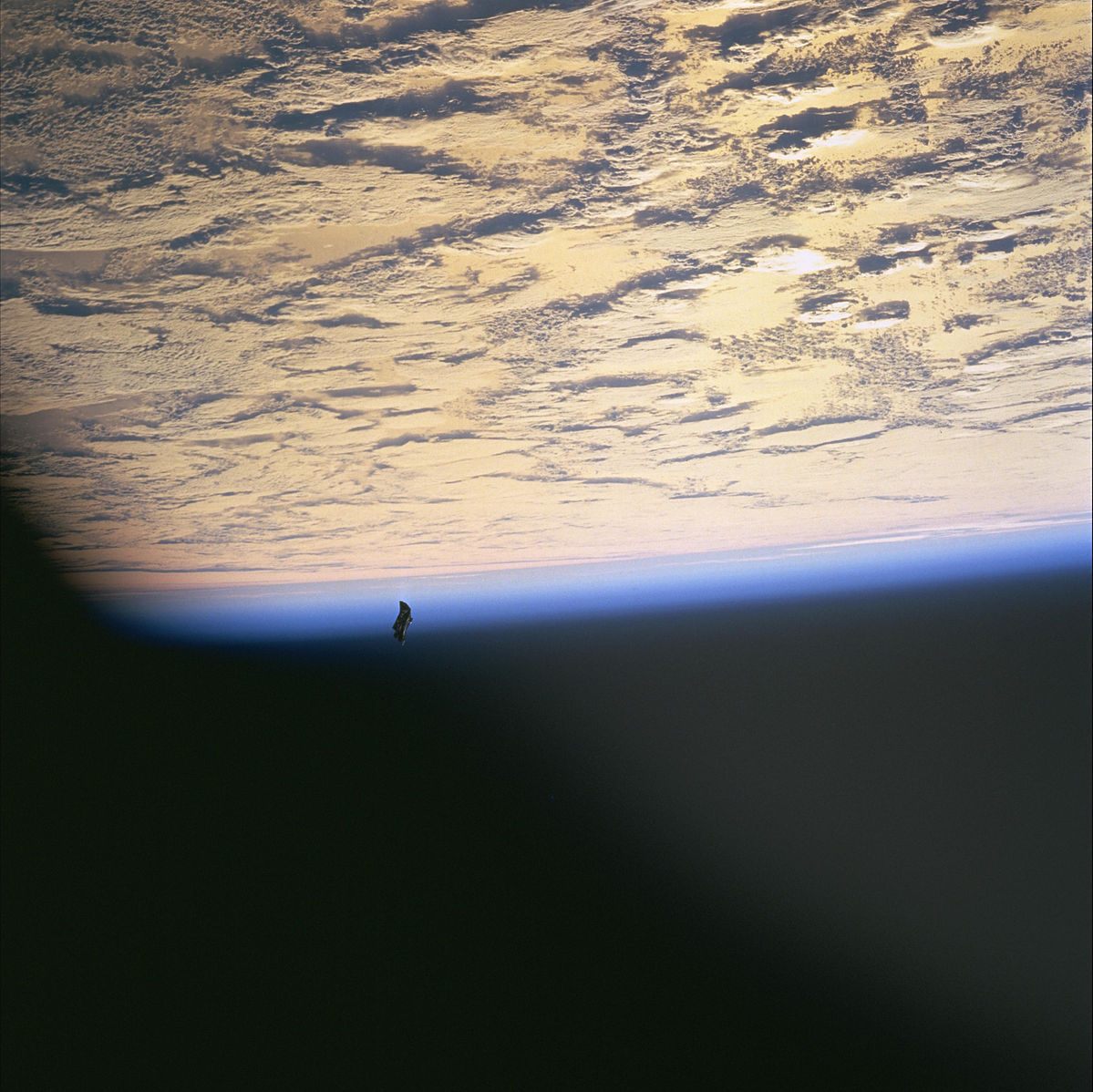The Weird History Of The Space Blanket
From refugee crisis symbol to conspiracy theory scapegoat, this shiny blanket means many different things to many different people.

The mysterious “Black Knight Satellite”—or, a space blanket that escaped from NASA and reinvigorated a decades-old conspiracy theory. (Photo: NASA/Public Domain)
Over the past year, over a million refugees landed on the shores of Europe, seeking asylum, aid, and, eventually, a new life.
Initially, at least, they got something else: A golden, crinkly space blanket.
Where disaster strikes, space blankets follow. Cheap, lightweight, and great at containing body heat, they are an indispensable first aid tool, used to warm people up after they’ve suffered through a shark attack, overexposure, or a treacherous sea crossing. The 2005 earthquake that devastated the Middle East inspired a stateside hiker to get 150,000 space blankets sent to Pakistan. After last year’s Paris attacks, photos showed shocked survivors draped in the gold fabric, gleaming in the dark.
A Syrian refugee girl covers herself with a thermal blanket after arriving on #Lesvos island,Nov.6 #refugeesGr pic.twitter.com/NWDvWxfd15
— ✌☮#UpTheRebels☮✌ (@Chara_fc) November 7, 2015
Space blankets look the way they do for practical reasons: they’re made out of plastic and thinly layered with vaporized aluminum, to maximize reflective capabilities while minimizing weight. But their incongruous appearance has given them additional, symbolic utility. As the refugee crisis continues, leaving them strewn across Greek and Italian beaches like strange jellyfish, they’ve become irresistible to artists, who have turned them into banners, moving sculptures, and, most controversially, celebrity outerwear.

“Emergency Thermal Blanket,” by Dionisis Christofilogiannis, recreates the Greek stripes and cross using space blankets. (Photo: Dionisis Christofilogiannis)
For another segment of the population, though, one particular space blanket has never been just a space blanket. It has a starring role in a Space Age conspiracy theory known as the Black Knight Satellite.
As with most long-lasting conspiracy theories, the Black Knight is a kind of catchall—it has no set identity, mythos, or sequence of events. Some think the entity—which manifests most often as a mysterious object in the sky—is an ancient Chinese technology, or an evil sort of ego incarnate; others don’t care what it is, as long as it’s real. A true believer will tell you it started about 13,000 years ago, when an alien civilization sent a satellite to circle Earth, for unknown but nefarious reasons, and for a limitless length of time. Others say it first made itself known in 1923, when it contacted Nicolai Tesla through a wireless receiver he built in Arizona (Tesla himself thought he was hearing from Martians). Still others tie it to mysterious radio echoes first heard in 1927, or trace it back to the 1960s, when Cold War panic turned every piece of space debris into a “dark satellite.”
But one thing is for certain. While most mystery satellites burned up in the collective consciousness in the late 1960s, the Black Knight returned with a vengeance in 1998—all thanks to a space blanket.

The loose space blanket floats above the earth. (Image: NASA/Public Domain)
Before space blankets were human first-aid essentials, they were basically interstellar ponchos, designed to shield Earth-built machines from the harsh environment of space. First deployed in 1973 to keep Skylab from overheating, they’re now an essential part of most crafts, custom-cut to fit everything from the Hubble Space Telescope to the 2005 Titan probe. “Space blankets are to spacecraft as clothes are to people,” Mike Weiss, a Hubble manager, said in 2007. Basically, don’t leave the home planet without them.
So in December of 1998, when six astronauts flew the NASA shuttle Endeavour up to the International Space Station, they brought along four space blankets, explains James Oberg, a former NASA Mission Control operative, science writer, and expert space conspiracy debunker. The team was tasked with with attaching the new American-made module to the existing Russian one, thus making the station truly international. After the successful attachment, some of the module’s trunnion pins—long metal rods that had attached it to the shuttle during transport —would suddenly be naked. Bare metal sticking out of a spacecraft acts like a hatless head in the winter, leaking heat out into space. So the team had brought space blankets to tuck in the trunnions, insulating them.
Space walks are tricky, though. At some point during the task, Jerry Ross, given several extra blankets to hold after he got ahead of schedule, dropped one. Video footage shows it flapping from his wrist; though the camera switches perspective before the blanket comes loose, one can easily imagine it drifting away, like a silvery balloon slowly slipping out of a child’s hand. “Jerry, one of the thermal covers got away from you,” radios Commander Robert Cabana from inside. “How did it do that?” Ross asks, with audible frustration. “Where’d it go? I don’t believe this.” They watch it float off, and discuss whether to attempt a retrieval.
But there was no getting it back. After radioing the news to mission control, someone in the shuttle began snapping photos of the runaway blanket. NASA gave it an official object number (025570), as they do with all sizeable pieces of space debris. After a couple of days spent in near-earth orbit, the blanket disappeared. Most likely it took a last dive through the atmosphere, and burned up.
But its symbolic life was just beginning. “After decades of no interest, some people found some pictures from the mission,” says Oberg. It isn’t clear exactly who resurfaced them, but even a quick glance at one of the images is enough to explain why they did. In some images, the blanket hangs just beneath the edge of the earth; in others, it swims across the clouds like a strange-angled shark. If there were a 13,000 year old alien satellite, it would probably look just like this. “That blanket is undoubtably the weirdest-looking whatzit people have seen in a space picture,” says Oberg. “It definitely looks like something Klingon.”
Attracted by this new photo evidence, all the old Black Knight stories zoomed together again, like scattered filings to a magnet. Ominously scored YouTube videos popped up, moving from Tesla through the Cold War and straight on to the blanket. Redditors and other forum truthers shared political theories and shroom-tinged encounters. Weirdly, even Pepsi jumped on the bandwagon, producing a short film about the conspiracy that came out last year.
In the mid 2010s, after speaking with Ross, Oberg publicly diagnosed the strange photos as blanket shots. Most mentions of the Black Knight now have this debunking baked in (sometimes in the form of a brusque “its a blanket”)—but despite this explanation, many remain in the Knight’s thrall.
Oberg, who has spent years trying to fathom why people cling to conspiracies, thinks he understands. After all, the blanket’s material, color, and even its shape are designed for otherworldy purposes. Outer space provides few perspective markers—a posterboard-sized blanket, shot at close range against the Earth’s surface, is hard to distinguish from, say, a huge alien machine photographed from far-off. “If you’re not used to looking for these unearthly clues,” Oberg says, “it’s absolutely normal that people would freak out.”
The blanket’s meaning isn’t fixed as an earthbound object, either. “The first time I saw migrants wearing thermal blankets,” writes Greek artist Dionisis Christofilogiannis in an email, “I had the feeling I saw gold flags fluttering.” For others, they spur despair and disenchantment: “We are still pulling bodies from the water wrapped in material which was meant to send us into space,” writes artist James Bridle in a recent blog post. It seems that in the sky or on the ground, the shiny fabric is really more of a lightning rod.











Follow us on Twitter to get the latest on the world's hidden wonders.
Like us on Facebook to get the latest on the world's hidden wonders.
Follow us on Twitter Like us on Facebook